Conduit
A conduit is an arrangement of still lifes and/or oscillators that move an active object to another location without themselves being permanently damaged. The object may be transformed into a different active object in the process, but no permanent debris may be left behind. Alternatively, gliders or other spaceships may be emitted; they will either abandon the site of their creation, or can be absorbed by eaters. Probably the most important conduit is conduit 1, in which a B-heptomino is transformed into a Herschel in 59 generations.
Herschel conduits
The most prolific stable conduits are those which rotate, reflect or translate a Herschel in a certain number of generations. Oscillators of all periods => 58 can be built using these elementary conduits. All except the smallest stable reflectors use Herschel conduits, the counter-examples being the Snark, rectifier, and boojum reflector.
Herschel conduits can be chained in order to form a Herschel track. Karel Suhajda's search program Hersrch automates the process of building a track.
- The Herschel conduits shown below are the initial universal set, discovered in the late 1990s and proven to be sufficient to complete an unlimited range of synchronization or computation tasks. Many more Herschel conduits have since been discovered. Conduits are code-named according to the final orientation of the output Herschel relative to the input Herschel, and the number of generations it takes for the output Herschel to reach the same phase as the input Herschel. For example, the R64 conduit performs a right turn in 64 generations; R designates right turn, L left turn, F forward motion, B backward motion and x flip ("forwards" is defined as along the shaft towards the T-piece).
- For conduits for symmetrical inputs (e.g. a pi-heptomino or queen bee), an asterisk (*) is used to denote that the conduit can be flipped to place the input either clockwise or counterclockwise. The resulting pair of conduits will have outputs in the same number of ticks, but they will be either L and Rx (L*), R and Lx (R*), or B and Bx (B*).[1]
- As shown below, the conduits transport the input Herschel (shown in green) to the position in magenta, and also produce a glider which escapes at lower left.[2]
- The two Bx conduits leave a block (shown in red) which has to be deleted by the glider produced by the output Herschel.
- In F166 and Lx200 the "input Herschel" never actually forms in the position shown, which is given to facilitate the concatenation of conduits. Instead, the block and Herschel-precursor react as shown in the insets, 3 generations before the nominal entry into the conduit.
- The number in brackets is the reset time, i.e. the minimum number of generations at which one Herschel can follow another through the conduit. However it may be necessary to dispose of the glider produced by the output Herschel to achieve some close spacings.
| R64 (61) | 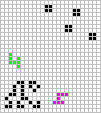
|
Fx77 (57) | 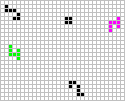
|
L112 (58) | 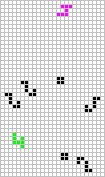
|
F116 (138) | 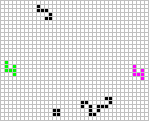
|
| F117 (63) | 
|
Fx119 (60) | 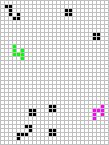
|
Bx125 (166) | 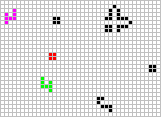
|
Fx153 (60) | 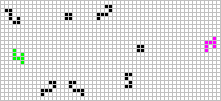
|
| L156 (62) | 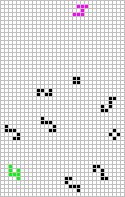
|
Fx158 (176) | 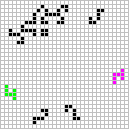
|
F166 (115) | 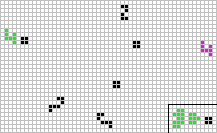
|
F171 (227) | 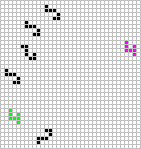
|
| Fx176 (92) | 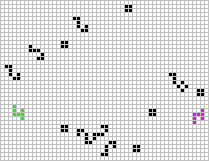
|
R190 (202) | 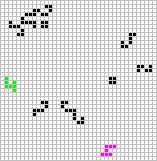
|
Lx200 (90) | 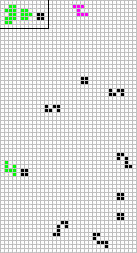
|
Rx202 (201) | 
|
| Bx222 (271) | 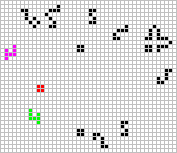
|
Many of these use the block+snake combination (conduit 1) in order to clean up the output B-heptomino to produce an output Herschel. Dave Greene, with the invention of his boojum reflector, discovered a way to remove this block using the first natural glider of the Herschel. However, these conduits are not considered 'elementary', since they contain a boojum reflector.
See also
External links
- Conduit at the Life Lexicon
Buckingham on B-heptominos in oscillators at Paul Callahan's Page of Conway's Life Miscellany Buckingham discussing stable reflectors and Herschel tracks at Paul Callahan's Page of Conway's Life Miscellany Stephen Silver on stable reflectors at Paul Callahan's Page of Conway's Life Miscellany
- [1] Brief summary of stable technology
References
- ↑ Jeremy Tan (December 7, 2018). Re: The Hunting of the Elementary Conduits (discussion thread) at the ConwayLife.com forums
- ↑ Dave Greene (August 26, 2017). Re: H-to-H conduit collection (discussion thread) at the ConwayLife.com forums (Herschel conduit stamp collection in Golly distribution)